SsangYong Tivoli XLV 1.6 XDI ELX 4WD

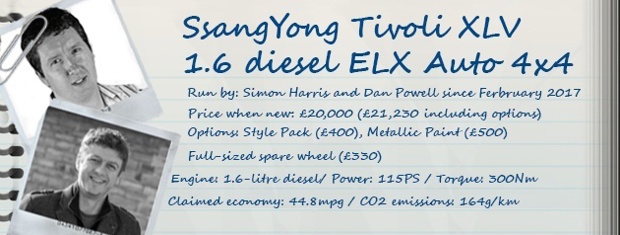
- Welcome to our SsangYong Tivoli
- Red leather day
- Smiles per gallon?
- Playing it safe
- Tivoli discovers SsangYong's 4x4 roots
- Oil change beckons as XLV racks up the miles
- Going long with the SsangYong
- Hello, is it hands free you’re looking for?
- Boxing day in July
- Five is the magic number when it comes to warranty
- Rough around the edges, but ready for anything
- Time to say so long to our SsangYong
Welcome to our SsangYong Tivoli
We say hello to the first SsangYong to join our fleet of long-term test cars - the Tivoli XLV.

Date: 14 March 2017 | Current mileage: 1173 | Claimed economy: 44.8mpg | Actual economy: 43.6mpg
We’ve started the year in a very fortunate position at Honest John, by getting hold of one of the new SsangYong Tivoli models due to arrive in showrooms later this spring. SsangYong is probably a brand that you won’t have heard much about until recently, if at all, but it is gradually expanding its model range, and plans to introduce a new car each year over the next few years.
Although the Tivoli only went on sale in summer 2015, with the more practical Tivoli XLV arriving a year later, both versions have been updated with a range of safety features for 2017 giving SsangYong what’s likely to be its first four-star car in the Euro-NCAP crash tests. The Tivoli achieved a three-star rating in 2016, but such is the nature of Euro-NCAP where merely adding preventative safety features can boost a car’s points score, the company is now confident of an improved rating next time round. We should point out many manufacturers have added safety features to cars when seeking to improve Euro-NCAP scores.
More on that in a later update – first we ought to introduce our test car. The Tivoli is SsangYong’s first compact car in the UK, although for a company with heritage in 4x4s, it’s understandable that the model has been designed as a small crossover.
This sector has undergone tremendous growth in Europe and the UK in recent years, and there are still manufacturers that haven’t launched vehicles into it yet. The XLV is a longer version of the Tivoli – more of a small estate car with some extra ruggedness built in.
The XLV is more practical than the standard SsangYong Tivoli
We chose the 1.6-litre diesel, which produces a maximum of 115PS and has a peak torque figure of 300Nm, the latter available from 1500-2500rpm. We also chose the optional six-speed automatic transmission over the standard six-speed manual, as the XLV would be spending a lot of time in stop-start traffic. The automatic gearbox is manufactured by Aisin – the same company that supplies Volvo.
And we chose the four-wheel drive version, for added security and traction in difficult road (or off-road) conditions. This specification is at the top end of the range, and is priced at £21,000 on the road. Our XLV has a top speed of 107mph and 0-62mph time of 12 seconds, It can tow a maximum of 1500kg, which is decent for a car of this size. For example, an equivalent Fiat 500X with four-wheel drive and automatic transmission is only rated for a maximum of 1200kg.
By the same token, its fuel economy of 44.8mpg on the combined cycle, with CO2 emissions of 164g/km, seem a little below par. The Fiat we mentioned, with 140PS, achieves 51.4mpg on the combined cycle, but it also has a more efficient nine-speed gearbox, compared with the Tivoli’s six-speed auto.
But we have noticed that the first few tanks of diesel have been just about on the money with the official test, and one was even better. We wonder how close to the official figure we would be had we been running a different manufacturer’s vehicle.
Red leather day
It's possible to customise your Tivoli with a variety of exterior and interior colours. Find out why we settled on a red interior.
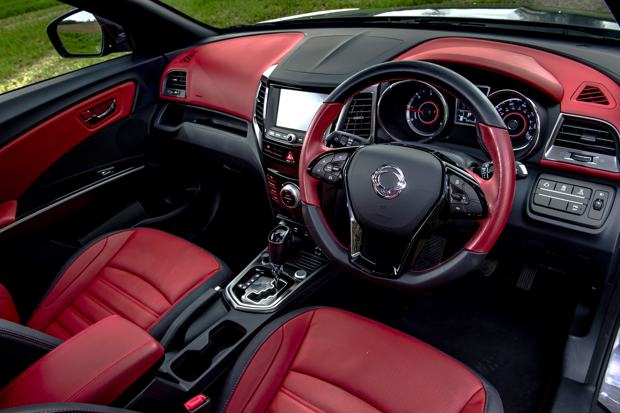
Date: 27 March 2017 | Current mileage: 2740 | Claimed economy: 44.8mpg | Actual economy: 44.1mpg
If you’re like me, a car interior containing swathes of dark monochrome plastic is a blight on the whole driving experience. We were fortunate with the SsangYong Tivoli XLV, as well as being able to have a two-tone exterior styling pack on ELX models (ours has a black roof and wheels with Techno grey metallic paint), we had a choice of interior colours.
The Tivoli XLV comes with leather seats as standard, and while the standard choices are grey or beige, it’s possible to specify the ‘red pack’ for an extra £350. We thought while grey seats and inserts in the doors and dashboard might have a sophisticated appearance in the compact Tivoli, they didn’t lend themselves well to being photographed in our regular updates.
Although beige offers more of a contrast, we decided to go for the red option as it stands out even more and small cars can usually accommodate bright colour choices without harming their prospects as used cars in a way larger cars can’t. It means the seat facings, door panels, steering wheel and dashboard have a contrasting red colour scheme.
The combination of the contrasting black roof outside, with black and red inside suits the chunky Tivoli XLV’s personality. The strong colour choices boost the attitude in the Tivoli’s upright stance and crossover proportions.
The Tivoli XLV's crossover stance is boosted by our strong colour choices
SsangYong cars have always been synonymous with value for money, even when in the past quality has been below par. The Tivoli XLV in ELX specification isn't 'cheap' in any sense, but with the list of equipment fitted as standard, it does look like a better value proposition than many rivals.
For example, the Tivoli XLV's standard price in ELX trim of £21,000 on the road, puts it on a par as the Peugeot 2008 1.6 BlueHDi 120 GT Line, priced at £21,365 on the road. But the Peugeot is neither available with 4x4 (it has Peugeot's Grip Control electronic enhanced traction system for front-wheel drive), nor automatic transmission for the diesel. You could expect those features alone to be worth around £2,000, while the Peugeot also comes with cloth seats, compared with the Tivoli's leather.
Another factor that appeals in the SsangYong ownership experience is a five-years/unlimited mileage warranty, covering major powertrain components in the event of faults for potenitally beyond the lifespan of the first owner's time with the car. It's true that others offer similar cover, but it is among the very best in the industry.
We're really racking up some motoway miles in the Tivoli's first few weeks with us, so anything that takes the shine off the experience is bound to come to the fore soon. Stay tuned.
Smiles per gallon?
We thought we'd been getting close to the Tivoli XLV's official combined fuel economy figure, but a few long motorway journeys has seen us do even better.
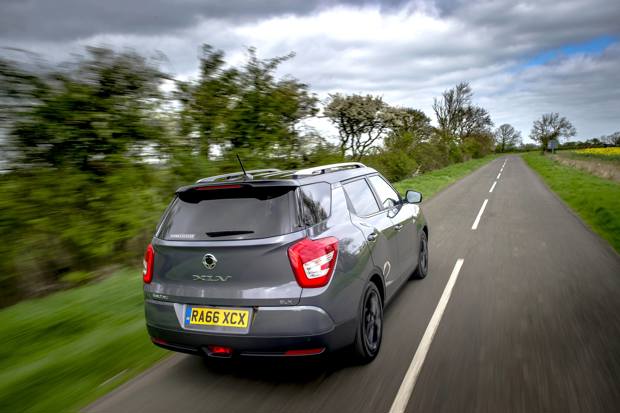
Date: 12 April 2017 | Current mileage: 3951 | Claimed economy: 44.8mpg | Actual economy: 45.2mpg
It used to be the case that automatic transmissions resulted in much higher fuel consumption than with manual cars. This was especially true in the 1980s and 1990s when most automatics were three-speed or four-speed gearboxes, when manual cars were typically four-speed or five-speed.
It meant the auto was typically in a lower gear than the engine would be at the same speed if the car were a manual, and therefore running at higher rpm and burning more fuel. This is without any other differences in efficiency between the manual and automatic.
Gradually traditional automatic transmissions have become more efficient, often with more gears than the manual equivalents, while electronic shifting manual transmissions and dual-clutch gearboxes have also become more common. But the Tivoli XLV diesel with automatic transmission lags behind the manual counterpart in terms of fuel consumption.
But despite an official figure of 44.8mpg on the combined cycle for the automatic, compared with 57.6mpg for the manual, I’m still inclined to go for the automatic because I tend to do many long journeys, and spend a lot of time stuck in motorway traffic jams. Other people who choose automatic transmissions do so for rational reasons, whether the fuel economy is worse or not.
The Tivoli XLV's six-speed auto is smooth, but thirstier than the manual
But it has been a pleasant surprise to find our Real MPG has been close to, and sometimes better than, the 44.8mpg official figure. In fact the previous tank of fuel – measuring the mileage achieved from the previous full tank until refuelling again, and checking it against the fuel used – has exceeded that figure.
I’m not really sure why the Tivoli’s six-speed Aisin automatic transmission performs badly compared with the standard six-speed manual, although I have found it will do better than 44.8mpg at a steady 70mph, particularly when the engine is warm. And I have seen the trip computer (which is optimistic by less than 2%) display more than 50mph as an average over more than 100 miles since refuelling.
PSA – the company that owns the Peugeot, Citroën and DS Automobiles brands – has recently decided to publish a ‘real world’ fuel economy figure alongside the official figures it has to advertise by law. The 120PS Peugeot 2008 1.6 BlueHDi is only available with a manual gearbox, so we’re not quite comparing like with like, but the official combined cycle figure is 76.3mpg, but Peugeot advises that 53.3mpg is a more realistic expectation on that model.
Also, the Peugeot comes with idling stop and start, which switches off the engine in traffic when the car is in neutral. This feature is not yet available on the SsangYong Tivoli, and while its benefit is debatable in real-world driving, there is a clear advantage on the official fuel economy test cycle. So far, we're not too disappointed with the Tivoli's results.
Playing it safe
The 2017 SsangYong Tivoli range comes with new safety features. We were able to try them out at one of the UK's biggest vehicle testing facilities.

Date: 3 May 2017 | Current mileage 5297 | Claimed economy 44.8mpg | Actual economy 44.2mpg
Safety is one of the priorities car buyers are likely to consider before deciding on the best option, and how safe a car is may be dictated by how well the structure will protect occupants in a crash, as well as any equipment available that can help prevent, or reduce the risk of, crashes or injuries.
One of the safety benchmarks that allows us to compare cars like for like is the Euro NCAP crash tests, where points and stars are awarded to highlight how a car performs in a crash. Last year, the SsangYong Tivoli was tested and achieved three stars out of five. But with safety being a key factor in purchasing decisions for many buyers, a three-star Tivoli would be a harder sell than rivals that have achieved four or five stars.
In recent years, as well as rating the performance of the structure of the car in tests, Euro NCAP has also awarded extra points, which contribute to the star rating, for certain items of equipment. A few years ago, it became impossible for a car to achieve a five-star rating in Euro NCAP if electronic stability control, which can help correct a car's line and allow the driver to regain control during a skid, wasn't fitted as standard to most models in a range.
Later the focus switched to other items, such as autonomous emergency braking, and, no doubt as the range of safety technology improves and becomes widely available, Euro NCAP will attempt to encourage greater take-up by increasing the relevance of these features when awarding points for its tests. Fortunately for SsangYong, as adding some equipment can boost a points score and improve a star rating, the Tivoli and Tivoli XLV have been able to benefit in 2017.
The driver is alerted when there's a risk of a collision with another vehicle.
And we took the opportunity to test this technology for ourselves in a controlled and safe environment at Millbrook Proving Ground in Bedfordshire. This year, the Tivoli and Tivoli XLV have been fitted with autonomous emergency braking and collision warning, as well as lane-keeping assistance. They have become possible with the fitting of a forward-facing camera at the top of the windscreen that monitors the road ahead for obstacles - other traffic - and, using lane markings on the road, can also help prvent the car from inadvertently straying into the path of other road users. The camera also monitors speed limit signs, and allows the addition of an automatic dipping main beam.
Driving the Tivoli at an obstacle - an inflatable, car sized object to mimic the presence of one, but not the damage should the technology fail - at a steady 20mph, counterintuitively trying to resist backing off the throttle or reaching for the brake pedal resulted in an audible alert and flashing warning light in the instrument panel. With no response from the driver, maxmum braking was applied and the Tivoli brought to a sudden halt with inches to spare in front of the 'car' ahead.
We repeated the exercise at 30mph, which resulted in the audible alert and warning light appearing earlier, as the technology calculated a faster approach speed and greater braking distance required. The brakes came on a little earlier, and the Tivoli, as well as the 'car' ahead, were both spared.
Autonomous emergency braking technology has been around for about 10 years now, and, no doubt, has been increasingly responsible for avoiding this type of crash as the number of vehicles on the roads using it has increased. It's good to see it appearing on a car as affordable as the Tivoli.
Tivoli discovers SsangYong's 4x4 roots
We took the Tivoli XLV off road recently to see what it was capable of. It turned out to be quite a lot...
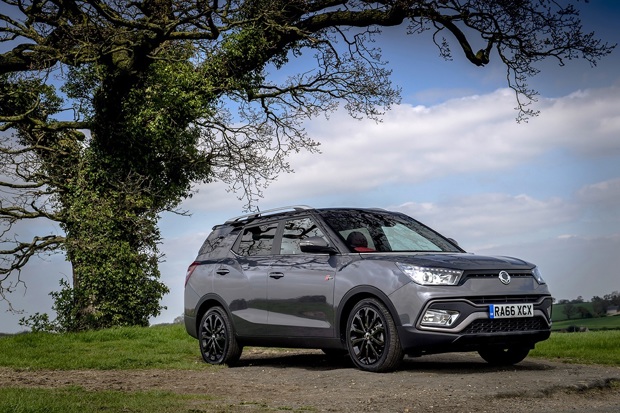
Date: 19 May 2017 | Current mileage: 6831 | Claimed economy: 44.8mpg | Actual economy: 45.5mpg
Most of the SsangYong models in the UK since the brand first appeared have been authentic 4x4s. From the five-door Musso and three-door Korando of the 1990s, to the Musso pick-up and Rexton of 2017, they have been capable of some serious off-road work.
The Tivoli, as SsangYong's first compact car, has a slightly different purpose. It's more of a crossover than an SUV, with most customers expected to choose two-wheel drive versions, but while it's in the same sector as the Nissan Juke and Renault Captur, you get the impression that it could outperform many road-focused rivals on trickier terrain.
Of course, 'getting the impression' isn't quite enough for Honest John readers, so when we had the chance to try the Tivoli XLV's new safety features at Millbrook Proving Ground, we also took the opportunity to drive one on the facility's off-road course. Not ours, I hasten to add - the car is planned to stay with us until late summer, so we couldn't risk any accidents - but a diesel 4x4 auto XLV in almost identical specification.
Like many crossovers, the optional four-wheel drive technology is an on-demand system, which means 100 per cent of drive is sent to the front wheels until sensors detect a loss of traction. Then some of the drive is transferred to the rear axle. So it means if you're driving on slippery roads, or wet or loose surfaces off road, the Tivoli is operating in four wheel drive.
We took a Tivoli XLV almost identical to ours on a tricky off-road course.
There is also a lockable centre differential, which distributes power equally between front and rear axles up to 25mph for the most challenging surfaces. And the optional six-speed automatic transmission fitted to our test car gives drivers the opportunity to shift gears manually via a switch on the right of the gearknob.
We tried a variety of terrain, including large, uneven humps, steep gravel-covered inclines and heart-in-mouth descents, as well as some mud and ruts. Although the Tivoli's ground clearance is greater than a typical family car, at 167mm, it's not quite as much as a medium SUV, which are usually around 200mm.
This means that some of the ruts we encountered were traversed with care, and areas where the dips and rises were more sudden and pronounced were best approached at a 45-degree angle. But it was more than capable of scaling the steep inclines and maintaining traction through the muddy parts of the off-road route.
It crept down the other sides, occasionally needing a bit of cadence braking as there's no electronic hill-descent control, and felt pretty comfortable with what the route - a toned-down version of the toughest off-road course at Millbrook - could throw at it. Factor in the Tivoli's maximum towing capacity of 1,500kg, and it stacks up as a great general purpose car, capable of harder work than most owners and their families will need it to do.
Oil change beckons as XLV racks up the miles
The SsangYong Tivoli XLV has done almost 9000 miles since we took delivery in February. We assess the car as it approaches its oil-change service.
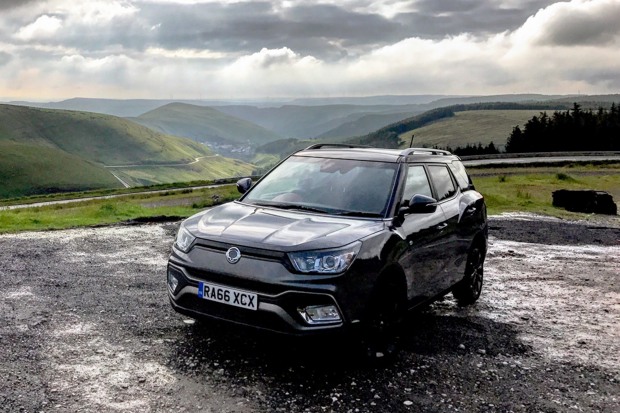
Date: 7 June 2017 | Current mileage: 9807 | Claimed economy: 44.8mpg | Actual economy: 44.5mpg
Almost 9000 miles have been racked up in the Tivoli with almost bewildering speed. It means that next week the SsangYong will undergo its intermediate service just over halfway into our six-month appraisal.
And it also marks the end of my three-month stint behind the wheel, before handing over to managing editor Dan Powell. It's a chance to look back on the last 9000 miles and consider whether its first impressions have been sustained.
The first test car I tried, 20 years ago, was a SsangYong and, in the 1990s, you did get the feeling that you were driving a budget car. This isn't the case with the Tivoli. It feels like a mainstream product with everything that occupants see and touch looking and feeling well screwed together. Nothing has broken or fallen off in the last 9000 miles, and we fully expect the car to look and feel just as sharp after another three months.
There are one or two inconsistencies with the technology not being fully joined up. The front-facing camera that observes road signs - those that display speed limits and 'no overtaking' instructions - displays the signed in the instrument panel. But it sometimes contradicts the TomTom navigation system, which is fed with older data, and won't recognise temporary speed limits in road works. Of course, the speed limit in the instrument panel is always the current one.

The Tivoli has travelled well during its first three months on our fleet.
Fuel consumption continues to be around the low- to mid-40mpg level, and perhaps could improve further as the engine runs in following its oil change. It's pleasing that it's around or better than the official combined MPG figure, but perhaps worrying that it isn't as good as for a four-cylinder diesel Range Rover Sport, which is a much larger and more powerful vehicle.
The 115PS diesel engine has been adequate to move the Tivoli XLV along swiftly enough, if perhaps a little noisily when the six-speed automatic transmission holds on to a gear for maximum acceleration, and while the car handles safely and predictably, we doubt it would work any better with a more powerful engine.
We also recently changed the steering setting, from 'comfort' to 'sport', which hasn't transformed the behaviour of the car, but the extra resistance in sport mode helps the Tivoli feel a bit more engaging than in the rather inert default comfort mode.
An omission that perhaps ought to be remedied in future, is the lack of a DAB radio. I was a digital radio sceptic a few years ago, especially as coverage in the riral East Midlands left a lot to be desired, but it really ought to be standard on every car on sale now. It feels a bit 20th century having to hear the crackles of FM radio as reception quality varies.
Going long with the SsangYong
Dan takes over the Tivoli XLV duties and finds plenty of long term appeal with SsangYong's compact SUV.
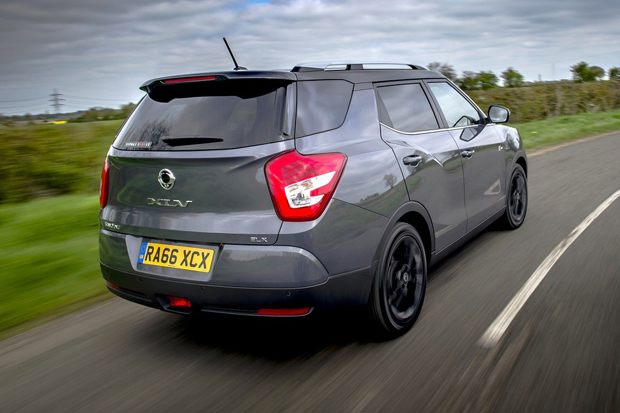
Date: 21 June 2017 | Current mileage: 10837 | Claimed economy: 45.0mpg | Actual economy: 44.5mpg
After a three month stint with Simon Harris, the time has come for me to take custody of the SsangYong Tivoli XLV and complete its long term test, with the Subaru Levorg going in the opposite direction.
Frugal fuel economy is something I value highly when it comes to family cars and the Tivoli XLV looks like it might be on course for a future Real MPG award, with it already peaking above its advertised 44.5mpg. Indeed, since taking the keys off Simon two weeks ago, the SsangYong has averaged at a flat 45mpg, which is extremely impressive given that fewer than one in five cars match their official economy ratings.
Value for money is another area where the SsangYong shines. Indeed, for £20,000, the standard Tivoli XLV 4x4 auto gets leather seats, keyless entry, automatic headlights and reclining rear seats. You get plenty of safety equipment too, including automatic city breaking, which means you get a lot of car for you money - even more so when you factor in its comprehensive unlimited mileage, five-year-warranty.
Our test car features a number of extras (£1230 worth to be exact) and bar the full size spare wheel (which costs £330), I probably would have stuck with the standard spec. Yes, the styling pack is nice, with black roof and spoiler, but I don't think I would have spent £400 on it. Neither would have had splashed out £350 on the garish red leather pack.

Comfortable and spacious, the Tivoli XLV is a competent long distance cruiser, but the red leather pack has failed to impress
One area that has already started to disappoint is the infotainment system. The graphics for the navigation are akin to something Sega was producing in the early 1990s, while the omission of DAB radio and a CD player makes the Tivoli XLV rather limited when it comes to entertainment when driving in rural areas. Thankfully, Bluetooth is supported, which means I can stream my MP3 player through the in-car speakers.
Over the past few weeks I've got to know the SsangYong quite well and have already put some 1000 miles on the clock. During that time I've found the ride to be extremely comfortable, with the supple suspension providing a soft ride that works really well with the firm and supportive leather seats.
The 115PS 1.6-litre diesel engine is well-suited to motorway work, although it does become quite vocal when pushed hard to join a fast flowing motorway. The six speed automatic gearbox does a good job of distributing the diesel engine's 300Nm of torque though, by dropping a gear and holding it just long enough to provide an additional boost when you need to overtake or find a gap when joining a dual carriageway.
Obviously, the Tivoli XLV is not built for speed, but it's nice to know it will shake a proverbial leg when asked to scurry away from a junction or roundabout. Sadly you pay a heavy premium for choosing the Tivoli XLV with the automatic. Indeed, returning an official 44.8mpg, it leave your seriously short when compared to the six-speed manual's 57.6mpg. That said, overall impressions of the compact SsangYong SUV remain extremely positive. It just remains to be seen if the red leather interior will grow or grate as the weeks and miles wiz by.
Hello, is it hands free you’re looking for?
Hello? Hello, can you hear me?! I'm on handsfree and on my way t....I said I'm on my wa...Hello? Hello?!
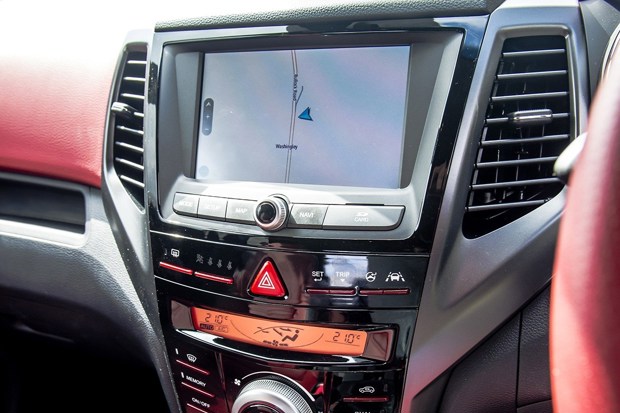
Date: 5 July 2017 | Current mileage: 11577 | Claimed economy: 44.8mpg | Actual economy: 44.5mpg
Trigger Happy TV was, during the early noughties at least, my favourite show. As a yoof, I would spend hours watching Dom Joly’s Channel 4 reality comedy series. And my favourite character? That would be the guy with the big phone who would always shout “Hello! I’m on the phone!” every time it rang. Sadly I don’t have a giant phone to shout down as I walk down the high street, but I can relive those teenager years by screaming “I’m on the phone” as I drive along in my SsangYong.
The problem lies with the fact that the handsfree Bluetooth system in the Tivoli XLV is, to be blunt, rubbish. I mean, it pairs up easily enough with my smartphone, but it struggles to convey anything I say to the person at the other end of the line. I’ve tried it with different phones, different areas and road types, but the mic drowns my words in static hiss and road noise.
The lack of technical refinement is evident in other areas of the Tivoli XLV, with lots of diesel din whenever you ask the engine to do something with pace. Yes, I know this is not a quick car, but a busy A road will produce considerable noise from the engine as you attempt to build up pace.
It's not all bad, however, as the Tivoli is extremely comfortable. The soft ride is perhaps one of the best aspects of this car and even a deep pothole will struggle to upset the suspension. As a result, you can rumble along the motorway for an hour or two, without the usual cramps or aches in the upper legs or lower back.
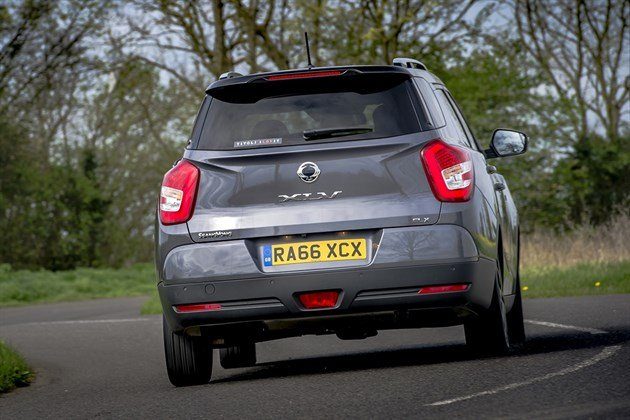
The Tivoli XLV is a fine motorway cruiser, but twisty A and B roads underline its limitations in the handling department
There is a compromise to this motorway mildness, however, with the soft suspension producing a fair amount of body roll. On straight, fast moving roads, it's not really a problem, but head onto a twisty A road and the Tivoli XLV will lurch into a moderate bend and pitch heavily under breaking.
The vague steering doesn't help matters. This can be remedied, in part. by switching from 'Comfort' to 'Sport' steering; however, while the wheel benefits from more feel, it doesn't improve the handling. Given that this car is not built for speed, it's perhaps not the greatest sin in the world, but there's no hiding the fact that the Tivoli XLV does not like to be hurried.
As a family daily driver there are lots of things to be positive about. Fuel economy continues to impress and the large interior provides plenty of practicality and reassurance when it comes to build quality. The plastics, for example, manage to tread that thin line between being plush and hardwearing, while everything is screwed together with impeccable detail. I've yet to hear a creak or squeak from the interior trim.
At £20,000, the Tivoli XLV lines up against some accomplished competition, with the Peugeot 3008, SEAT Ateca and Nissan Qashqai all vying for buyers' attention. But, even with its minor shortcomings, the Tivoli XLV stands out with high levels of standard equipment and five-year-warranty.
Boxing day in July
Dan has been working the SsangYong Tivoli XLV hard over the past few weeks. Has it risen to the challenge?
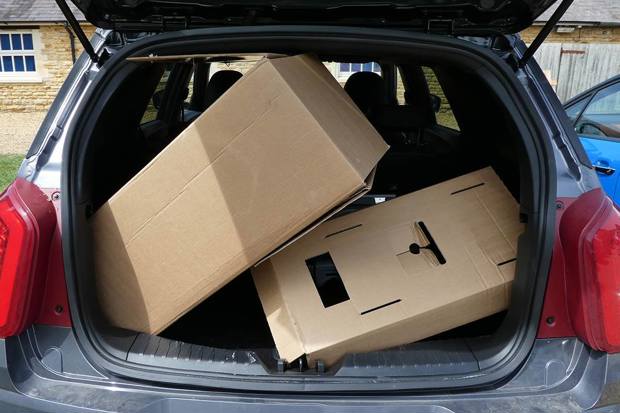
Date: 19 July 2017 | Current mileage: 12154 | Claimed economy: 44.8mpg | Actual economy: 43.9mpg
Few cars can compete with a large SUV when it comes to shifting clutter. And few people take as much satisfaction I do when it comes to pressganging a family car into service as a van. The decision to fill the SsangYong with junk came as I noticed that my spare room was looking more akin to a poorly kept warehouse, with cardboard boxes and bubble wrap - from old product tests - strewn all over the floor.
Until recently, I’d done a pretty good job of ignoring the mess - and my girlfriend’s complaints – by shutting the door and loudly stating that “I’ll do it next weekend”. However, with the weekends turning into months and months turning into 1.3 years, I discovered that my string of excuses were starting to wear as thinly as the deflated bubble wrap that strew the spare room floor. Thankfully the SsangYong was more than up to the task of shifting it all, in one fail swoop.
With 60/40 split rear seats and a maximum of 1294 litres of bootspace, the Tivoli XLV has the perfect proportions for shifting bulky items. It also proved easy to load, with the wide boot opening making short work of large boxes. The loading high loading lip proved a little bit of a pain at times, but after a few hard pushes the boxes were in, along with a broken heater and several acres of bubble wrap.
Removing the load cover took seconds to complete and the hardwearing carpet – that covers the boot floor and the back of the leather sear – refused to snag, no matter how much things bounced around as I took the narrow B-road to my local tip. All in all, a job well done.

The Tivoli majors on boot space, although the higher loading lip does make loading a bit of a hassle
Restoring the Tivoli back to its SUV state was easy, with the rear bench snapping back into place with a firm push and the load cover clicking back in. The only marks left from the exercise were on the plastic wheel arch covers, but a quick wipe with a wet cloth soon removed these and the SsangYong was back to being good as new.
Large and well-equipped, the Tivoli XLV is great value for £20,000. The four-cylinder 1.6-litre diesel continues to average in the mid-40s and the leather driver’s seat provides excellent support for long distance runs. The suspension is also excellent and supple, which means I've yet to receive a single criticism for the ride quality from my passengers.
The only issue that has been raised comes to the refinement. The engine is noisy - especially when joining the motorway - and both wind and road noise can become an issue when the weather or roads permit. I also find myself questioning why no one at SsangYong thought to add DAB audio as standard. I mean, the Tivoli XLV has almost every other conceivable extra fitted at no extra costs, would it have been such a hardship to add digital radio?
Yet, despite being rough around the edges, the Tivoli XLV gets more right than it does get wrong. And with prices starting at £18,750, it's difficult to think of a large SUV that will provide as much space or kit as the SsangYong at this price range.
Five is the magic number when it comes to warranty
The SsangYong's five-year unlimited mileage warranty provides peace of mind when it comes to the Tivoli.

Date: 2 August 2017 | Current mileage: 12709 | Claimed economy: 44.8mpg | Actual economy: 44.7mpg
The SsangYong Tivoli XLV might not be the most refined SUV in its class, but it's certainly one of the most honest. Not only does it manage to match its advertised fuel economy on a regular basis, but it's also backed by a comprehensive, unlimited mileage five-year warranty.
So that's five-year cover on everything from the engine and suspension, to the wheel bearings and steering joints, to the in-car audio. What's more, if you buy new, you'll also get a 12,000 mile/12 month warranty for the brakes and clutch components too. And there's no exclusions either, which means taxi drivers will get the same cover as a private buyer. That's perfect for Turismo buyers.
Now, before I start to sound like a SsangYong salesperson, I should point out that they are not the only ones offering a five-year warranty. Hyundai offers a similar fully transferable cover, while Toyota and Subaru provide five-year warranty - albeit with a limitation on mileage.
And Kia? Well they wipe the floor with the lot with seven-year cover. But the point I'm trying to make is that a big warranty should be a big selling point for any car buyer who wants an affordable family SUV with rock bottom running costs.

The Tivoli trumps the opposition on price, even afer you factor in the optional £330 spare wheel
While on the subject of South Korean carmakers, I should point out that neither the Hyundai Tucson or Kia Sportage come close to matching the Tivoli XLV on value, with both requiring at least £26,000 to match the spec of my leather clad SsangYong with four-wheel drive and an automatic transmission.
Thousands cheaper than its core rivals, I'm stumped as to why more cost conscious buyers are not snapping up the Tivoli XLV. For sure, it's not the sharpest tack in the box when it comes to handling or refinement, but its hassle free and low cost motoring for five-years. What's not to like?
Well, for enthusiast and style-led buyers I would imagine that the boxy and obscure SsangYong would not win many people over at the golf club. Likewise, family SUV buyers who simply change their car every time they renew their PCP every three years will care little for the Tivoli's long term ownership proposition.
However if, like myself, you are old fashioned and love to root out a deal by actually owning a car outright, the SsangYong is a savvy buy. Personally, if I was in the market for a new or nearly new family SUV, I'd be finding the cheapest loan I could find and be snapping up a Tivoli XLV.
Rough around the edges, but ready for anything
It might lack refinement of its rivals, but the SsangYong Tivoli XLV remains an endearing choice for the money-saving buyer.
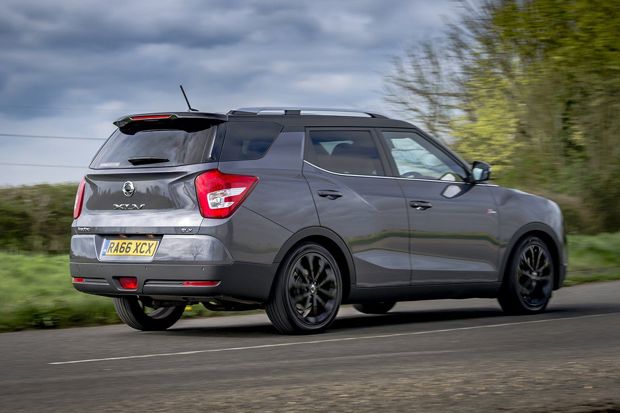
Date: 16 August 2017 | Current mileage: 13587 | Claimed economy: 44.8mpg | Actual economy: 44.9mpg
With the weeks ticking by, it’s nearly time to say so long to the SsangYong Tivoli XLV; however, I have to admit that I’ve grown quite fond of it. Yes, it’s lacking in refinement. And yes, the diesel engine clatters like a juggler who’s just been given his P45, but the Tivoli XLV is honest and ready for anything.
As things stand, the SsangYong is peaking just above its official fuel economy, which means £35 will last me the best part of a week. I've also found the supple ride to be perfect for long hours on the motorway, with the soft but supportive leather seats providing excellent back and upper leg support.
As shown in my previous update, the Tivoli XLV is extremely practical, with its large boot and 60/40 split folding rear seats providing plenty of space for moving heavy and bulky items. The durable plastics are also more than up for the task of moving furniture, with a quick wipe with a wet cloth being enough to remove scuff marks.
To be honest, the build quality is extremely good overall. Everything inside feels like it has been screwed together and hammered in to the cabin with the force of a Norse god, which means the Tivoli XLV provides plenty of reassurance that it will fulfil its unlimited mileage five-year warranty without so much as a squeak from its plastic and leather trim.
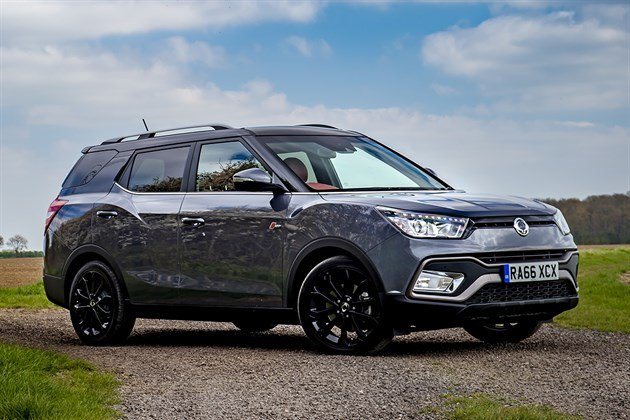
With honest fuel economy and a bulletproof warranty, the Tivoli XLV has won over our Dan
In fact, the Tivoli XLV reminds me a lot of the Suzuku Baleno. Like the SsangYong, the Suzuki won't ever win any beauty pageants, but it delivers where it really matters with outstanding value and real world fuel economy. The little Baleno was also robust enough to survive a Russian winter, while its large interior would transport four adults in comfort.
If you value style and rewarding handling, however, the Tivoli XLV will never win you over. Indeed, I don't think any enthusiasts would care for the overassisted, woolly steering or 0-62mph time of 12 seconds. But, the SsangYong isn't aimed at the Audi and BMW buyers. Far from it.
Living in Cambridge, I've found life to be surprisingly easy with a mid-size SUV. The rear view camera makes parking painless, while the wide door mirrors make it easy to spot a wayward cyclist or passing moped.
The only gripe I really have is with the lack of DAB. Indeed, the noisy diesel engine and abundance of road and wind noise would be partly excused if I could drown them out with the audio system. Sadly radio is hit and miss on signal and the in-built speakers lacking in any audible depth. But in the greater scheme of things, these criticisms are relatively minor.
Time to say so long to our SsangYong
After six months with the HonestJohn.co.uk team, the time has come to say goodbye to the Tivoli XLV.

Date: 30 August 2017 | Current mileage: 14051 | Claimed economy: 44.8mpg | Actual economy: 44.9mpg
Frugal. Practical. Safe. Uninspiring. These are the words that sum up the Tivoli XLV. For the most part it has been a reliable and practical addition to the fleet, but there is no hiding the fact that this SUV falls way short when it comes to refinement.
For many SUV buyers none of this will matter. Indeed, the Tivoli XLV's unlimited mileage, five-year warranty will be the deal breaker. Unlike some of its rivals, SsangYong's warranty pretty much covers everything from the engine and suspension, to the wheel bearings and in-car audio. Yet, for what you get in given in value, the SsangYong takes away with poor refinement.
The biggest issue lies with the vocal 1.6-litre diesel, which really grates the senses after a couple of long hours behind the wheel. Take it from us, there is no hiding the fact that this is a diesel. It clatters heavily under start-up and easily drowns out the radio when accelerating hard to join a motorway. It's a pity it's so loud because this engine is one of the most honest when it comes to running costs.
Over the past six months, the Tivoli XLV has remained faithful to SsangYong's claimed 44.8mpg. What's more, on some occasions, it's even surpassed its advertised figure, which means it hasn't been uncommon for the trip computer to display an average of 50mpg over a long journey.

It might be lacking in refinement, but the 1.6-litre diesel is honest when it comes to economy
To be fair to the Tivoli, you get a lot of car for your money. Our test car, for example, is advertised at £20,000. And for that you get leather seats, navigation, metallic paint and automatic headlights and windscreen wipers. Neither the Hyundai Tucson or Kia Sportage come close to matching the Tivoli XLV on value, with both requiring at least £26,000 to match its spec.
I should also mention that, along with a six-speed automatic transmission, our Tivoli also features four-wheel drive. And it's a very accomplished off-roader too, with its lockable centre differential distributing power equally between front and rear axles up to 25mph for the most challenging of surfaces.
The decision to buy a Tivoli XLV will ultimately come down to your personal taste and needs. Those looking for upmarket SUV with limo-like refinement and the latest tech will not be impressed with what's on offer here. The SsangYong is simply too agricultural and crude to appeal to those who want a swish car to win over the Golf club set.
However, if impressing a bunch of snobs sounds like a costly and pointless exercise for your car then the Tivoli XLV will have plenty of appeal. Easy to drive, capable in all weathers and hugely practical, it provides excellent value for money. It also has one of the best warranties in the business and, with maximum towing capacity of 1,500kg, stacks up as one of the best general purpose cars you can buy for £20,000.
